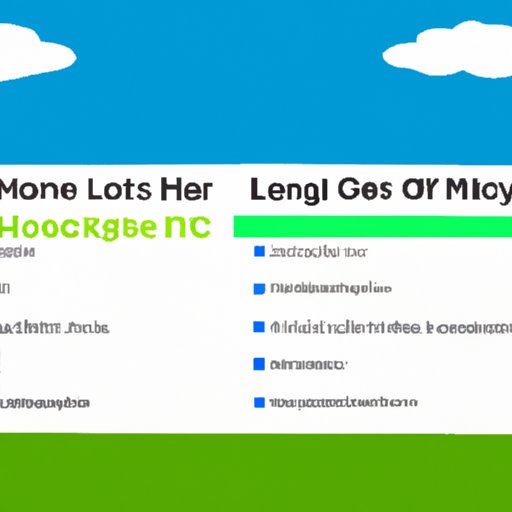Introduction
A Home Equity Line of Credit (HELOC) is a type of loan that allows homeowners to borrow against the equity in their home. It’s a revolving line of credit that can be used for a variety of purposes, such as making home improvements, consolidating debt, or financing an education. This article will explore the pros and cons of using a HELOC on an investment property, how to qualify for one, and tips for maximizing the benefits.
Exploring the Pros and Cons of Using a HELOC on an Investment Property
When considering whether to use a HELOC on an investment property, it’s important to consider both the advantages and disadvantages.
Advantages of Using a HELOC on an Investment Property
Using a HELOC on an investment property can provide a number of advantages, including:
- Lower interest rates than other forms of financing
- Flexible repayment terms
- Ability to leverage your existing equity
- Tax deductions on the interest payments
Disadvantages of Using a HELOC on an Investment Property
While there are many advantages to using a HELOC on an investment property, there are also some potential drawbacks, including:
- Risk of foreclosure if you are unable to make payments
- Possibility of higher interest rates over time
- The need to pay closing costs and fees
- Potential for negative amortization

How to Qualify for a HELOC on an Investment Property
In order to qualify for a HELOC on an investment property, you must meet certain criteria. These include:
Credit Score Requirements
Most lenders require a minimum credit score of 680 or higher in order to qualify for a HELOC on an investment property. However, some lenders may be willing to work with borrowers who have lower credit scores.
Income Requirements
Lenders will typically require proof of income in order to assess your ability to repay the loan. This could include W-2s, pay stubs, tax returns, or bank statements.
Equity Requirements
Most lenders require at least 20% equity in the property in order to qualify for a HELOC. If you don’t have enough equity, you may need to take out a traditional home equity loan instead.
Understanding the Tax Implications of Using a HELOC on an Investment Property
When using a HELOC on an investment property, it’s important to understand the tax implications. The interest payments made on the loan are usually tax deductible, but there are other considerations to keep in mind.
Interest Payments
The interest payments made on a HELOC are generally tax deductible up to a certain amount. The IRS limits the amount of mortgage interest that can be deducted each year, so it’s important to consult a tax professional to ensure you are taking advantage of all available deductions.
Deductible Expenses
In addition to the interest payments, there may be other expenses associated with the HELOC that are tax deductible. These could include loan origination fees, appraisal fees, title insurance, and other closing costs.

Strategies for Leveraging Your Investment Property with a HELOC
Once you’ve qualified for a HELOC on an investment property, there are several strategies you can use to leverage your investment. These include:
Refinancing
Refinancing is a process in which you replace your current loan with a new loan with better terms. This can be done in order to reduce your interest rate or monthly payments, or to tap into the equity in your home. Refinancing your HELOC can also help you avoid negative amortization.
Cash-Out Refinancing
Cash-out refinancing is a process in which you refinance your existing loan and take out additional funds in the form of cash. This can be used to pay off high-interest debt, fund home improvements, or even purchase another property. However, it’s important to be aware of the risks associated with cash-out refinancing, such as the possibility of increasing your loan balance.
Tips for Maximizing the Benefits of Using a HELOC on an Investment Property
When using a HELOC on an investment property, there are several steps you can take to maximize the benefits. These include:
- Shopping around for the best rates—it pays to compare different lenders to find the most competitive rates
- Considering all options—it’s important to weigh the pros and cons of each option before making a decision

Comparing Home Equity Loans to HELOCs for Investment Properties
It’s also important to understand the differences between home equity loans and HELOCs. While both are types of loans that allow you to borrow against the equity in your home, there are some key differences that should be considered when deciding which one is right for you. These include:
Loan Amount
Home equity loans typically offer larger loan amounts than HELOCs. This means that home equity loans may be better suited for larger projects, such as major renovations or purchasing another property.
Fees
Home equity loans often come with a variety of fees and closing costs, while HELOCs typically do not. This makes HELOCs more attractive for those who are looking to borrow a smaller amount of money.
Terms
Home equity loans typically have fixed terms, meaning the interest rate and payment amount remain the same throughout the life of the loan. HELOCs, on the other hand, have variable terms, meaning the interest rate and payment amount can change over time.

What to Know Before Taking Out a HELOC on an Investment Property
Taking out a HELOC on an investment property is a big decision, and it’s important to understand the risks involved. Here are some things to consider before taking the plunge:
- Understand the risks—it’s important to understand the potential risks, such as foreclosure if you are unable to make payments
- Research lenders—it pays to shop around to find the best rates and terms
- Read the fine print—make sure you understand all of the terms and conditions of the loan before signing on the dotted line
Conclusion
Using a HELOC on an investment property can be a great way to leverage your existing equity and take advantage of lower interest rates and flexible repayment terms. However, it’s important to understand the risks involved and carefully research lenders before taking out a loan. By understanding the pros and cons of using a HELOC on an investment property, you can make an informed decision about whether it’s the right choice for you.
(Note: Is this article not meeting your expectations? Do you have knowledge or insights to share? Unlock new opportunities and expand your reach by joining our authors team. Click Registration to join us and share your expertise with our readers.)
